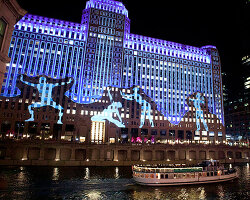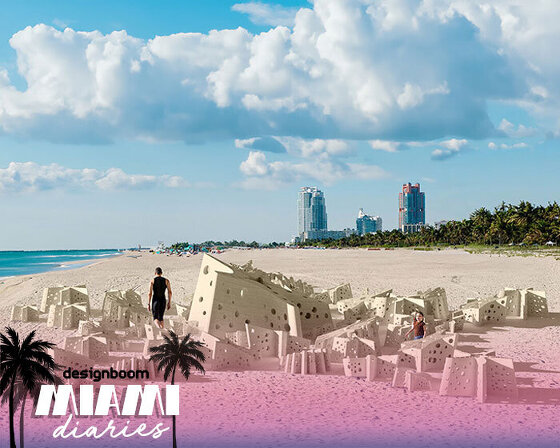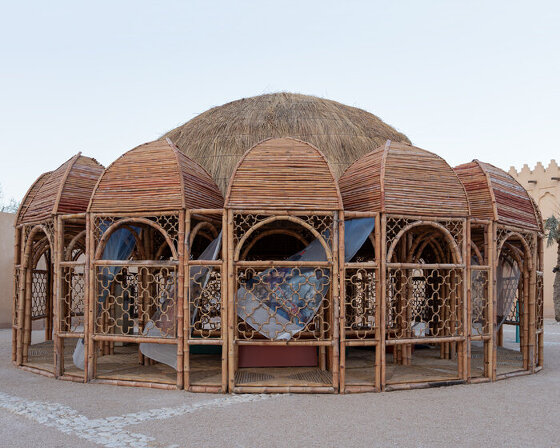the threads of igshaan adams
poetic but grounded, absorbing yet calming, both visible and invisible, south african artist igshaan adams deals with the contradictions of his own lived experiences in a new major solo exhibition at the kunsthalle in zurich, switzerland.
born in 1982, adams grew up in cape town during the latter period of apartheid, a system of institutionalized racial segregation that came to an end in 1994. as a creole with malay roots, adams was classified as ‘colored’. a practicing muslim, he grew up with christian grandparents. in this new exhibition, which is on view until may 22, 2022, adams weaves together the threads of his identity, recalling the domestic spaces he grew up in and the experiences that left a lasting imprint on the artist.

installation view of igshaan adams, kicking dust at kunsthalle zurich (2022)
image by annik wetter
kicking dust at kunsthalle zurich
titled ‘kicking dust’, the name of the exhibition makes reference to an indigenous south african dance where clouds of dust erupt from performers’ energetic footsteps. adams first saw the dance as a child among his grandparents’ nama community. in this solo show, the dust clouds become intricate sculptures made of spiralized wire and beads that are suspended in a garden-like space. the tangled sculptures and woven carpet installations on the floor trace a pathway around the exhibition space of the kunsthalle, echoing the unplanned pathways—or ‘desire lines’—found across cape town. meanwhile, woven wall hangings represent the worn linoleum floors of adams’ childhood as well as the invisible traces of who once walked there.
ahead of the opening of ‘kicking dust’ at kunsthalle zurich, designboom caught up with the artist at engadin art talks (E.A.T.) in the last weekend of january. in this interview below, adams discusses his artistic practice, the teachings of sufism, the influence of women, and the different masks we wear.

installation view of igshaan adams, kicking dust at kunsthalle zurich (2022)
image by annik wetter
designboom x igshaan adams interview
designboom (DB): during your presentation at engadin art talks, I was struck by your flooring artwork. I found it visually compelling and it carries a very strong message. how did this project start?
igshaan adams (IA): I graduated from a small art school in cape town in 2009. my graduation project was a typical south african living room installation. I borrowed furniture pieces from all the members of our immediate community, including some flooring, and I put this living room together. my grandmother was performing, she was inside doing what you would normally do at home. I also had self portraits on the walls of this living room in different guises; me as a woman, me as a conservative muslim. it pictured me in different guises, showing different aspects of my identity.

installation view at blank projects, cape town
IA (continued): for that installation, I had borrowed some of this linoleum flooring from a neighbor to make it look authentic. the first time I moved this piece of linoleum, I knew that this was something I could explore. I looked at it and thought there must be some information, some residue, some marks left behind in this physical space of what happened to people that leave mental marks, you know, emotional scars. so I was looking at the physical side of it as a way to delve deeper into my own world. the floor became that place where I could go and find marks. I became seriously intrigued by this position of humility.
my earlier works included ‘in between’ where I created a floor installation composed of stitched-together prayer rugs, which had been used by many people over many years, leaving imprints of the body. then I layered blankets underneath and made it very soft for people to walk on and very inviting. I burnt incense and people were asked to remove their shoes. and in that act alone of removing your shoes and sitting on the floor, there’s something quite grounding and humbling.

installation view at blank projects, cape town
DB: did you know about cindy sherman when you did the portraits?
IA: unfortunately, not at the time.
DB: it’s a common thing to dress up as another, to enter into a different character…
IA: at the time, the question I was asking myself was more religious. why do I seem to have this different social mask with different people? when I speak to my priest, to the imam, or when I speak to my grandparents or my friends, there seems to be a different persona that takes over. I became aware of this thing that I put on, and the question for me was – is it possible to just be the same in every environment despite who you are interacting with? am I able to be the same person with the priest as I am with my best friend? and I came to the conclusion that this social masking is actually quite necessary. what I find interesting is that of all people, my brother, I think, is probably the one person I know who is able to be himself no matter who’s around. and I don’t think it’s working for him.
because of this question, I ended up looking at the mystical side of islam, sufism.
DB: can you tell us a little bit about your religious background?
IA: my mom was born christian and she converted to islam when she married my father – and my father was born a muslim. but we ended up being raised by my mom’s parents, who were christian. my grandmother was a very religious christian woman who loved islam. she had a lot of respect for it because she was such a disciplinarian herself. she appreciated the discipline she saw in muslims and in the community. her best friend was also muslim and when we came around, she decided to raise us muslim but also to teach herself islam. she would fast with us during ramadan and she would invite the imam to our house to teach us and her the quran. she was an uneducated woman, she couldn’t read or write, but she tried to learn as much as possible so she could best teach us. so, we grew up in this home where it was me and my brother being muslim, and then everybody else was christian, but we celebrated everything and we were also allowed to participate in any christian activities. if we wanted to go and enjoy something at church, we were welcome to do that.

igshaan adams, 23 prunus street, bonteheuwel (2020)
DB: is your artwork heavily influenced by sufism?
IA: for sure, I think at this point sufi islam has become the lens that I see the world through or how I operate in the world. I think my art is very much informed by what I was taught by my sufi teacher, who was an older woman.
IA: it means remembering who we are in a state of forgetfulness when we have to put a lot of effort into remembering who we truly are. and I think it’s that question I spoke about earlier of wanting to know who I was, wanting to know if my physical body as a baby was placed in a completely different environment, how would I operate differently? it’s mind-boggling, right? especially in a place like south africa, where your physical appearance determined how you were treated and your life trajectory in such a big way. I mean, I was classified in the 80s as a second-class citizen, when my brother was classified higher than me, even though we had the same parents, purely because his eyes and hair were lighter and his skin tone was lighter than mine. from the start, depending on what you look like, that is where you will end up in life. I had to sit with this question: in a different environment, within a different body even, how would I think differently? how would I operate differently? how would my views be different?
DB: do you think there really is a self?
IA: well, that’s an interesting question. of course, I think that’s kind of where you end up on this path of sufism, is the depth of your desire or what we call the base desires or the ego. that is the point, to kind of kill off these desires, to the point where you are then open to guidance, where life becomes not your own. and of course, then you become one with everything. one way of looking at it is a beautiful belief in sufism, that everything external is a reflection of the internal world. so the moon, the stars, the universes, they all exist in some way internally. and just like the moon governs the waves of the ocean, we have this kind of moon that governs our emotions. this is understanding of an external and internal, and this membrane that is a pulse, that things flow constantly, you know, we internalize. so, I would have internalized a lot of that teaching earlier on that I was second class, that I would never be that good. I would never be a fully actualized human being because of my body. I think I found a lot of freedom in sufism from that early conditioning.

igshaan adams, 23 prunus street, bonteheuwel (2020)
IA: I have to say that I was never really an academic. I was concerned about being too influenced externally. and I was more curious about what was there already. in fact, I was enrolled in a university and then dropped out because the lecturers were all pushing things on me that I didn’t agree with. so I went to the sufi teacher, who was also an uneducated woman and just walked the path. I was greatly influenced by the people in my domestic environment, particularly by the women. I mean, I grew up in this very strong female environment.
DB: did you know from an early age that you wanted to go into art and creative work?
IA: well, we weren’t really exposed to art at all. I mean, there was no art for me growing up, other than my father making sketches of me and my brother. then my aunt, who, later on, would stay with my grandparents, my mom’s sister, she used to throw images on the wall, which I always thought was magic. I thought that this was her magical ability. so, there was a big influence from my home. all my aunts were crafters because there were no resources, it was always about going to the garden, making things from sticks, making things from leaves, it was about whatever was available. it’s not what it is, but what it could be.

igshaan adams, 351 bonteheuwel ave (II) (2020)
DB: due to the pandemic, not much has been happening for so long… has it been the same for you?
IA: well actually not for us you know. when everybody else was struggling during the pandemic, it seemed to me things went in the opposite direction. we were very busy during the pandemic and we were also allowed to work according to the south african rules – I only needed to do five weeks of lockdown. then they opened the economy and we were one of the first groups that were allowed to open because according to the government, my business is a manufacturing business. then I just started working with casey kaplan gallery in new york. things went well. we were very busy. in fact, I have never been so busy, and continue to be, I mean, the first six months of this year are gonna be… wow!
DB: are you into NFTs?
IA: I’m trying to wrap my head around it. I’m still getting there. I feel like I’m the opposite of that. NFTs… I think it’s probably gonna stay and so, I think I’m getting into it but I don’t see myself making any of this point.

igshaan adams at engadin art talks in switzerland
image © designboom
E.A.T. is internationally recognized for bringing together leading artists, architects, writers, scientists and disruptive thinkers from around the world. its mission is to provide an interdisciplinary platform for a global dialogue on the arts and different creative fields. internationally recognized for its line-up of leading artists, architects, writers, scientists, and disruptive minds from all over the world, E.A.T. has invited so far more than 140 speakers that have presented their ideas and visions on challenging social relevant themes since its inception in 2010. E.A.T. was founded by cristina bechtler together with hans ulrich obrist.
art interviews (162)
engadin art talks (E.A.T.) (23)
exhibition design (648)
sculpture (403)
PRODUCT LIBRARY
a diverse digital database that acts as a valuable guide in gaining insight and information about a product directly from the manufacturer, and serves as a rich reference point in developing a project or scheme.



















